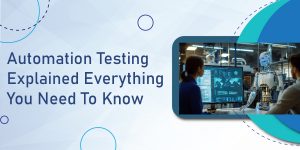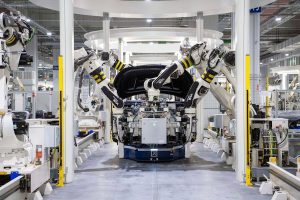The Future of Test Automation: Emerging Trends and Technologies

Having a thorough understanding of the current testing landscape and its historical evolution is crucial to understanding the future of test automation and the emerging trends and technologies within this field. In the last decade, there has been a paradigm shift in the enterprise IT environment.
It was not very long ago, even the biggest firms predominantly depended on a limited group of key financial, ERP (Enterprise Resource Planning), and HR (Human Resources) systems that were at the heart of their business operations. As a rule, these applications were placed on-premise and run internally.
It is important to understand this historical context, since it represents an entirely different IT environment from what we have nowadays. There are a number of milestones that have contributed to the shift in today’s dynamic and changing surroundings. Today, organizations no longer rely on a few centralized systems like in the past but adopt a more diversified, often cloud-based software environment.
The factors that drive this transformation include:
- The rise in cloud computing.
- The high proliferation of SaaS applications.
- The increase in the use of mobile and online platforms for businesses.
As such, the testing landscape has had to evolve to address these challenges.
Current State of Test Automation
Fast forward 10 years, and a different picture. All businesses, regardless of industry, understand the need for deep transformation in the face of increasing disruptions. There are new enterprise suites from companies like Microsoft, Salesforce, Workday, ServiceNow and others. Other major software application platforms like SAP and Oracle., have spread fast through organizations and woven across various organizations.
Organizations have started to use best-of-breed cloud solutions to address business-related functions and address gaps while at the same time complying with a series of national and international regulations, including the GDPR.
Emerging Trends in Test Automation
The combination of all these forces bring about higher levels of change in the IT environment, and this excludes the changes that CIOs and their teams will need to make as a result of recent industry trends and hot topics. The top test automation trends and technologies that are shaping the testing landscape today include:
Cloud-Based Cross Browser Testing
You no longer need to make your website responsive for certain mobile, tab, and desktop. Now, many companies and customers prefer a site developed with a mobile-first approach. Currently, there are hundreds of devices in the market with different resolutions and browsers. Setting up such a big testing regime is quite expensive. Due to this reason, a majority of companies and individuals have started shifting to cloud-based browser testing platforms.
In 2023, the use of such platforms has gained significant popularity. It has helped if you started getting involved in such test automation trends. Moreover, if you use a cross browser automation testing platform like LambdaTest, you effortlessly carry out automated and manual testing of your web and mobile application across 3000+ real browsers, devices, and OS combinations.
Continuous Testing
As many of these feature elements are delivered by external vendors through SaaS, many business processes now stretch across multiple deployment models, leading to an increased need for automation. Moreover, it is not easy to keep pace because many SaaS vendors have testing and release cycles of their own. For instance, some software vendors only allow a three-day window for testing every month before updates go into the production instance.
The internal application development programs within the teams are also being forced to speed up their operations concurrently. In light of these temporal and resource limitations, it’s little wonder that the majority of organizations realize that their traditional testing models can no longer keep up with the changing needs of their applications.
The ultimate solution is to adopt an automated approach that allows you to begin testing as early as possible during the project’s life cycle so that you can eliminate your QA backlog and roll out new products and innovations faster. Agile development, then, can only be matched with the most effective form of automation, and the end-to-end testing must be completed repeatedly and iteratively to ensure quality.
Robotic Process Automation
RPA is a new technology that has already been implemented in almost all companies of various sectors and has successfully improved business processes and reduced costs. RPA has been gaining popularity, considering it has lots of advantages over traditional process automation methods. It is quicker, more accurate and scalable when applied appropriately and in suitable conditions in the digital space.
Codeless Test Automation
Codeless test automation has been known to the industry for years, but there will be an enhancement of low code and no code automation in the future. The revolutionary approach allows testers and developers to automate the test cases without considering the codes. The maintenance is free, and the cost of automation drops to a minimum. The product also offers businesses an effective environment for creating automation suites.
AI-Driven Testing
The whole software development life cycle can be simplified by the application of artificial intelligence in testing. AI-driven tools can reduce the painstaking aspect of software development and testing, and automate the entire process. Though a fairly new concept, AI-based tools in automation testing can add value by enhancing test coverage, preventing bugs in numerous testing activities, generating test cases quickly by replicating the style of test writing and delegating repetitive and cumbersome maintenance tasks to AI. Moreover, analytics driven by AI and ML can consolidate multi-source and multivariate information so as to detect patterns and present a single integrated enterprise view of the process.
Automation of BlockChain Applications.
The word blockchain technology sounds like bitcoin or other cryptocurrencies. However, the scope of blockchain technology has expanded a lot. It is also employed in food, shipping, supply chain management, and so forth. That is why – blockchain security is the best possible security one can have for a financial transaction.
Among the top test automation trends to look for in 2023-24 will be the increasing demand for QA experts with specific domain knowledge of blockchain app testing. It should, however, be noted that domain knowledge is not the only thing required from testing professionals but they should also have a basic idea of automated tools. Popular tools include the Ethereum tester and Exomum Testkit.
Such tools help you assess if a transaction is executed and the API works in blockchain. The agile approach to development is usually used in blockchain development. However, when it comes to testing, the shift left approach is becoming popular so as to reduce the number of failures.
Agile and Test Automation can Complement Each Other.
Several of these industry experts predicted the death of scrum. However, the fact is that most organizations all over the world are still reliant on Agile methodologies.
COVID-19-driven remote work settings are expected to maintain the spotlight on agile development techniques in 2023-2024. An agile testing strategy will help to increase transparency and flexibility. It guarantees fast deployment, shorter time to market, and higher ROI due to how quickly it accelerates the rate at which several apps may interact with each other.
With continuous integration, developers can integrate their code into a repository so that they can easily detect coding errors even during the software development process. Therefore, it implies that substantial problems could be resolved in the preliminary stages of development.
Robotic Process Automation in Testing
RPA has been one of the hottest issues in the field of business for the last few years. RPA is a technology that enables us to automate the rule-based and repetitive tasks that humans perform. RPA is the next phase of the digital evolution. This technology does not stop with process automation; it can completely change the way we work.
Automated testing and RPA are different, but they have certain common things in it. Both of these solutions are also efficiency-boosting tools designed to run fast and autonomous from human intervention. In this regard, setup and maintenance is crucial to any automation with autonomy. There are a number of tools that can assist the design of accurate automation for test and RPA, such as process discovery, which is able to capture business processes in a stepwise manner automatically.
Ideally, they should feature orchestration and scheduling capabilities and include connected analytics and reporting as well as automation asset
The new Forrester report, “RPA And Test Automation Are More Friends Than Foes,” explains how to speed up innovation and scale automation with the combination of automated testing and RPA technologies. Key findings include:
- RPA and Test Automation: Common Strengths – Enterprises are assessing test automation platforms as a means to support task automation for business applications. Just like that, they are looking at RPA for testing. There are clear areas of depth and sharp contrasts, as well as overlapping areas.
- Enterprise’s scale automation opportunity with RPA and testing tools: Testing discipline, methods, and tools add the structure and quality support that RPA bots require. On the other hand, QA Teams can employ RPA platforms to develop sophisticated business process test scripts.
- RPA bot maintenance, resiliency, and software quality inhibit scale maintenance – the high cost of RPA-based bots makes it challenging for the enterprise to scale automation. Test automation tools can help.
RPA creates an opportunity to do more with less as it relieves the burden of rote, mundane or inefficient tasks through automation. In order to understand the real worth of RPA, automation should be scalable and adaptable to the dynamic changes in the environment.
Bottom Line
The future of test automation is promising and full of opportunities because of the convergence of emerging technologies and changing business settings. The transformation from the traditional on-premise systems to the present varied cloud-based software environment has also necessitated a transformation of the testing techniques.
The industry’s response to the dynamic IT ecosystem is reflected in key trends and technologies in test automation, such as cloud-based cross-browser testing, continuous testing, robotic process automation (RPA), codeless test automation, AI-driven testing and automation of blockchain applications.
The fact that agile methodologies are integrated with test automation shows the value of adaptability and efficiency in software development. The Agile practices provide for faster deployment, more transparency, and consequently, lead to shorter time-to-market and greater ROI.
The merger of RPA and test automation brings an exceptional chance to simplify processes, boost productivity, and expand the level of automation. Organizations can exploit the strength of both technologies to optimize operation processes, cut costs, and increase software quality.
It is clear that the future of test automation lies in the combined use of innovative technologies, testing strategy aligned to business goals, and adaptable and efficient approaches, which are relevant in the current changing digital environment. Adoption of these trends and technologies will no doubt aid in greater productivity, quality, and success when it comes to test automation.
Moreover, LambdaTest, a top player in the test automation space, empowers companies to understand and leverage the changing dynamics. LambdaTest provides a powerful cross-browser testing tool that allows users as well as businesses to conduct quick and effective browser testing from the cloud on any number of real browsers, gadgets, and operating systems that total over 3000. LambdaTest demonstrates how breakthrough solutions for software testing are about to create reliable, interactive, and interoperable applications in the modern digital world.






